As the women’s branch of the British Army during the Second World War, the Auxiliary Territorial Service (ATS) was formed in 1938. Women serving in the ATS were tasked with the ultimate aim of ‘freeing up’ men for combatant roles on the front line.
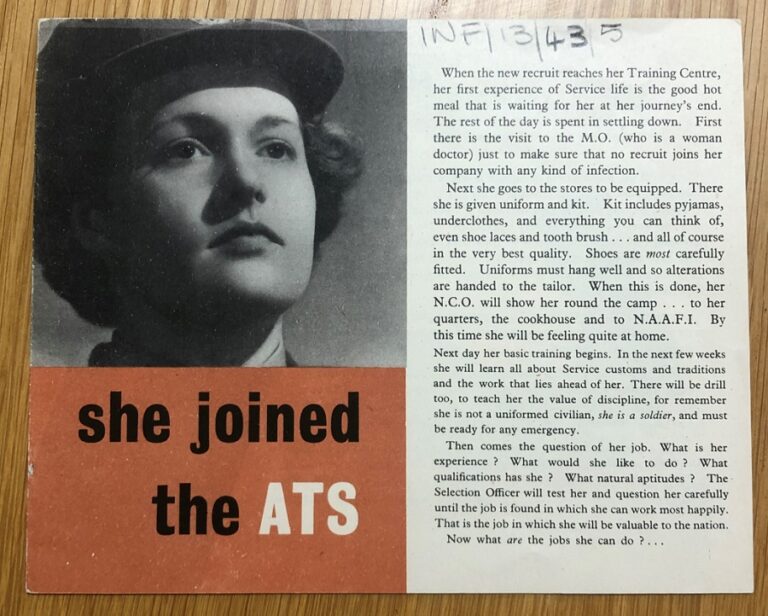
From switchboard operators and clerks, to photographic developers, drivers and electricians; for many women, the Service afforded new opportunities to take up work in fields previously inaccessible to them. By the end of the Second World War, up to 250,000 women had served in the ATS.
While most served in the UK, a small proportion of women volunteered for overseas service. Typically, this was dependent on them meeting a set of strict conditions, and, at least initially, tended to have a long waiting list (INF 13/43/7).
In certain overseas commands, local recruitment was also permitted. This was especially prevalent in the Middle Eastern Service where recruits were drawn largely from Palestine, most of whom were Jewish women of European descent (WO 169/6827). Recruits were also drawn from countries such as Greece, Egypt, Syria, India and Cyprus. According to the War Office history of the ATS, at its peak in March 1943, over 5,000 women were serving with the ATS in the Middle East, 80% of whom were non-British nationals (1949, p.103).
The Middle East
With special authority given by the War Office, the ATS first established itself in the Middle East two years after its official formation in the UK. First arriving between November and December 1940, the pioneers of the Middle Eastern Service were a small party of 50 to 60 British women, attached to the Combined Services’ Detailed Interrogation Centre (CSDIC) in Maadi, Egypt. Comprised of intelligence officers, batmen, messengers, cooks, clerks, orderlies and telephonists, the secretarial and translating work carried out by these women was stated to be ‘of great importance, needing personnel with high linguistic qualifications and absolute integrity’ (WO 208/5628).
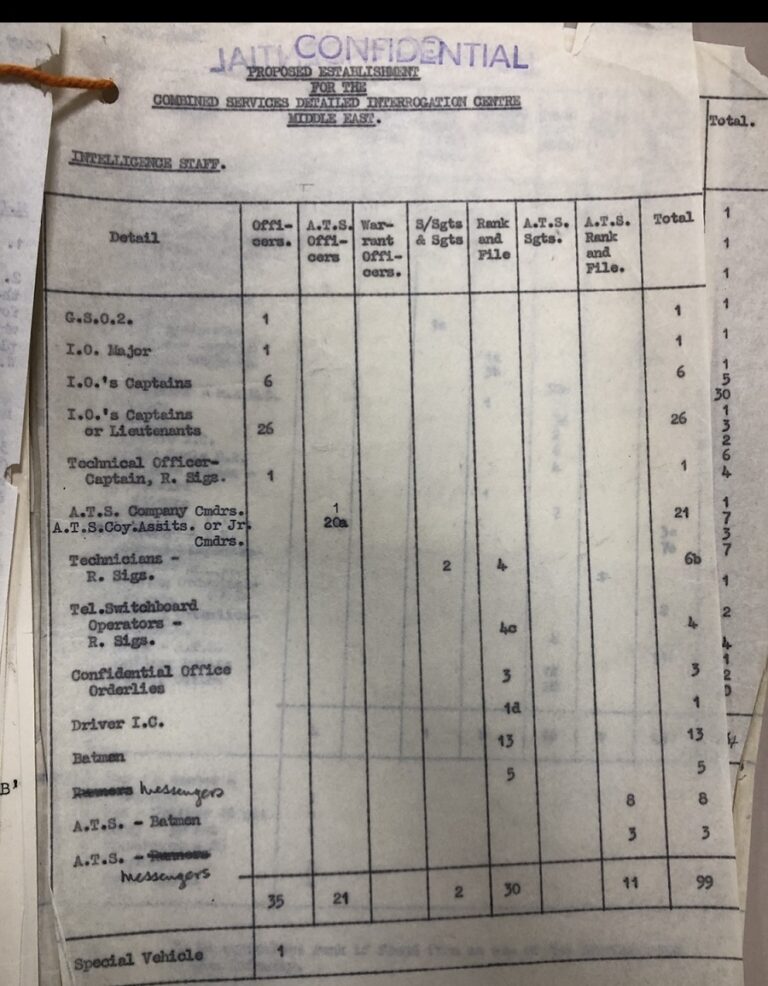
In addition to being the first members of the ATS to be posted to the Middle East, these women formed the first overseas establishment of ATS anywhere outside the UK. The detachment would later become known as 501 Company.
Palestinian ATS
The following year, in November 1941, the second ATS unit in the region was formed. Billeted in Alexandria, Egypt, this small detachment, known as 502 Motor Ambulance Convoy Company, was again comprised entirely of experienced British women, previously members of the Mechanised Transport Corps, a civilian uniformed organisation.
Just one month later, a small party of British officers and NCOs, tasked with raising a Palestinian ATS, arrived in the region. With recruitment commencing almost immediately, the first necessity was deemed to be the selection of local recruits who seemed likely to be suitable officers and NCOs. The second being to establish an appropriate training depot at Sarafand, Palestine.

On 18January 1942, the first batch of recruits arrived at the depot to begin their cadre training. Eleven days later, on 29 January, it was already noted by the British officer in charge that things were progressing well, the women were ‘smartening up very considerably’ (WO 169/6827). On 12 March 1942, the first cadre passed out.
Following this, the first ‘ordinary’ recruits’ course began, with recruitment for the Palestinian ATS continuing steadily for the duration of the war.
502 Motor Ambulance Convoy Company
Some of the first Palestinian recruits to be posted from the Sarafand Training Depot arrived with 502 Company in Alexandria, Egypt on 15 March 1942 (WO 169/6832). This initial Palestinian group consisted of around 20 women, with a large majority assigned as clerks, and the remainder as drivers.
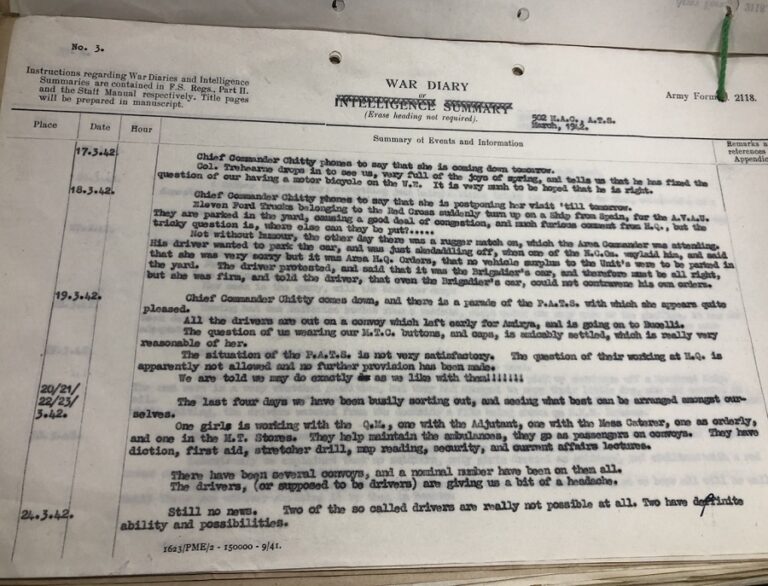
From the unit’s 1942 war diary, it would seem that organising the new Palestinian recruits, and integrating them into the already well-established 502 Company, proved somewhat of a challenge. As noted just four days after their arrival, ‘the situation with PATS (Palestinian Auxiliary Territorial Service) is not very satisfactory … We are told we may do exactly as we like with them!!!!!!!’ (WO 169/6832). On multiple occasions over the course of their first month, the Palestinian drivers were also said to have been inadequately trained, with Junior Commander Otto noting in no uncertain terms, that they had been giving her ‘a bit of a headache’ (WO 169/6832).
Despite these initial problems, the Palestinian recruits were described as seeming ‘cheerful and keen in their jobs’ and by May, had been better organised and assigned to specific roles (WO 169/6832). The drivers were also stated to have been ‘making good progress’.
1942
In consideration of escalating tensions throughout the region in 1942, the work carried out by the Palestinian ATS during this period had never been more vital. By the end of the year, 12 new ATS companies had been formed across both Egypt and Palestine, (503-514).
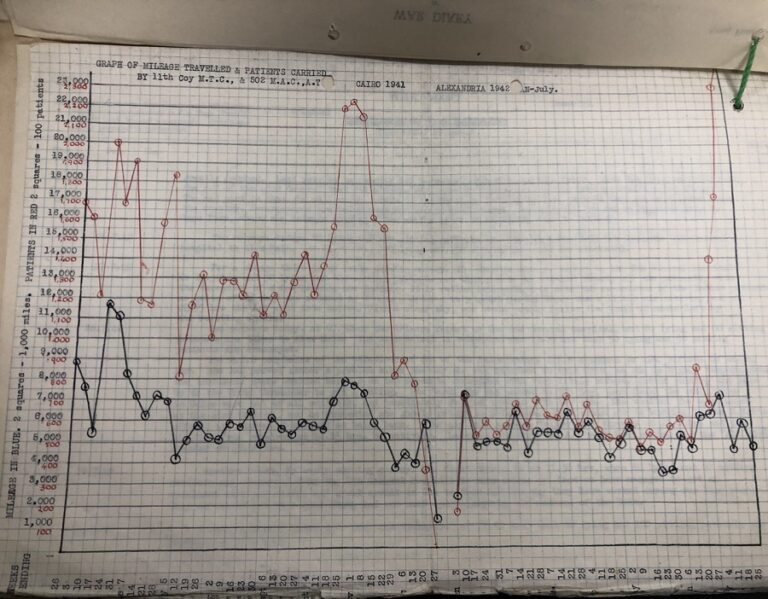
Although technically women were not permitted to serve on the front line, many were often working under trying conditions, placed in dangerous situations, both on and off duty. In one particularly harrowing instance on 2 July 1942, women serving in 502 Company were woken in the early hours of the morning to ‘the most ear-splitting noise, as a German dive bomber zoomed down over the house tops and discharged a stick of bombs’ (WO 169/6832).
Enemy encounters
Women serving in the Palestinian ATS were placed not only in situations that threatened their safety, but also plainly awkward and uncomfortable ones too. The following is an extract taken from the 502 Company war diary in October 1942, detailing one Palestinian auxiliary’s experience of driving some German prisoners from 64th General Hospital to the Prisoner of War Camp nearby:
The men registered every degree of surprise when they saw a girl driving their ambulance. ‘Was she driving them?’ The girl, a Palestinian from Berlin, ‘was’. ‘Did not women drive in Germany now?’ ‘Oh yes indeed.’ ‘Ambulances?’ ‘Oh yes indeed.’ ‘In uniform?’ ‘Certainly not. German women did not need to be decked up in fancy uniforms to do their war work.’ Conversation waned, until the prisoner took it upon himself to direct the driver to go to the left or to the right. He had been there before. Decanted at the camp, he enquired, ‘How much do I pay for the taxi?’ The driver half smiled, ‘Nothing’, she said ‘now, you will all pay for it after the War.’ (WO 169/6832).
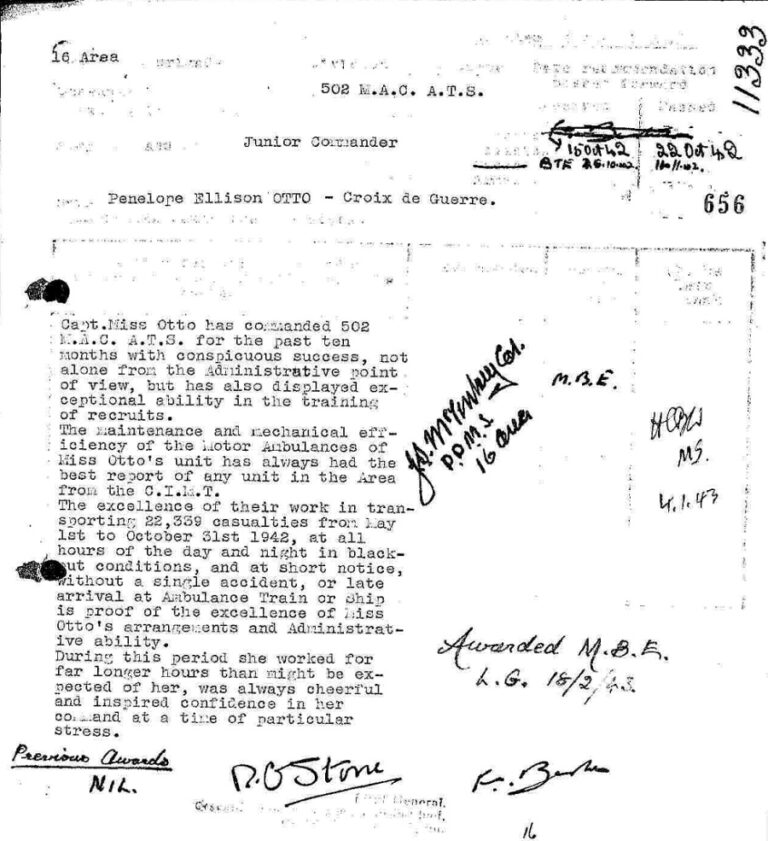
By the close of the Second Battle of El Alamein in November 1942, the excellence of 502 Company had been noted in at least six dispatches. In February 1943, Junior Commander Penelope Ellison Otto was awarded an MBE for her successful co-ordination and administration of the unit. On the recommendation for her award, it was noted that between 1 May and 31 October 1942, 502 Company successfully transported 22,339 casualties, at all hours of the day, at night in blackout conditions, and at short notice, without a single accident (WO 373/76/574).
Serve to conquer
By 1946, more than 30 ATS units had been established in the Middle East. Spread across both Egypt and Palestine, these included a Signal Company (524), both Egyptian and Palestinian Provost Units, as well as a Driver Training Wing.
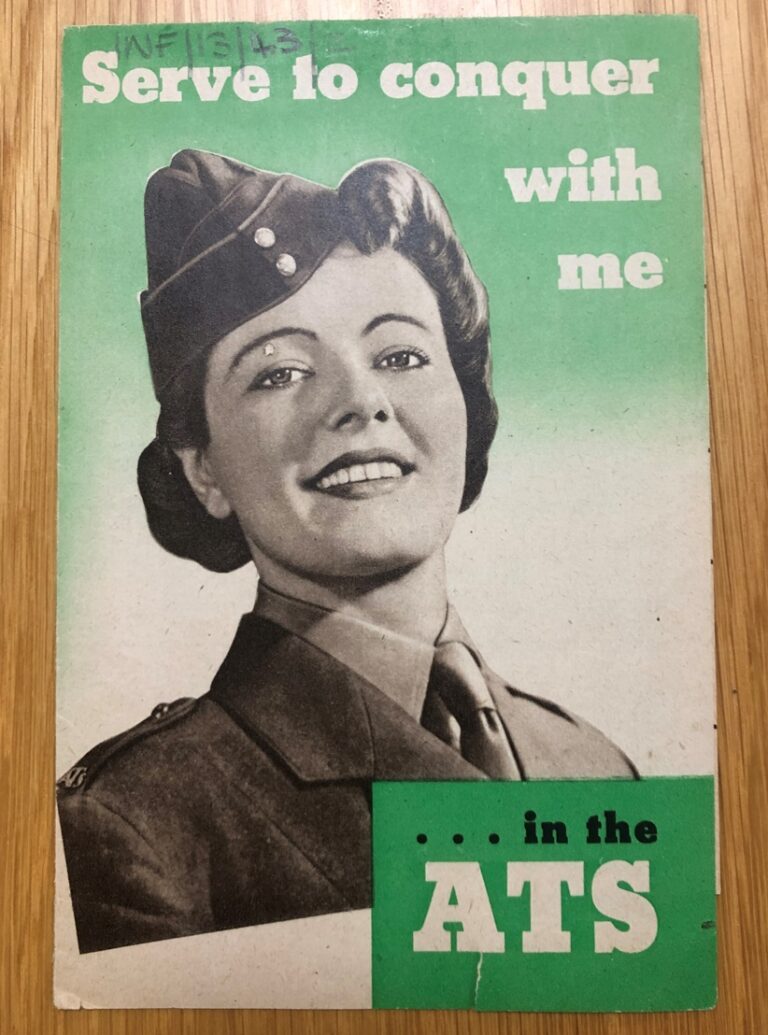
On the eve of Holocaust Memorial Day, I would like to dedicate this blog to the thousands of Jewish women who served in the Palestinian ATS, and ultimately their rising up against the Nazi Regime. The impact of their service cannot be overestimated. This was undoubtedly ‘their war’ just as much as it was ‘ours’ and I, like so many of us, am thankful for their service.
not many of them left now ,but where ever you are ,you have earned your place above
RIP, god bless.
Fascinating article and I love all of the pictures of the primary documents! I live in the US, but got my degree in history and portray Auxiliary Territorial Service with a group of other women, and had been trying to find out a lot more info on specific units in the Mediterranean, and would love to see any photos that might be around of 501 Company at the interrogation centre in Maadi, or of the 502 Motor Ambulance Convoy Company.
I’ve also been trying to find details on the 1st and 2nd Mediterranean Groups ATS and their sub-units attached to the British 8th Army.
A great start but more to uncover. My mother was a Palestinian ATS volunteer, 8/44 to 11/46. To date I have been unsuccessful in recovering her service records. Beyond knowing she was at Sarafand initially, then at Qassassin, Egypt with 4th General Hospital as a nursing orderly and then to Italy in support of the Jewish Brigade, I have no other details.
Grateful for pointers re uncovering the missing information, particularly when ATS members were assigned to other units.
Sounds like our mothers were doing the same thing. I think my mother enlisted perhaps a little earlier and was discharged in 46. She was at Sarafand then Egypt I think either driving an ambulance or being a nursing orderly and then in Italy, in the Assisi region as a nursing orderly. Her name was Etta Freilich. After she was discharged she went to nursing school in Tel Aviv and worked in the Yarkon Hospital there I think during the war and she left in 1952 when she married my father, an American Gentile Air Force sargeant who was a radio operator on the plane attached to the American Embassy. I have a small booklet that lists the details of her service. I don’t know what records the British might have had. I don’t have it convienant but it details her enlistment dates and all her duty stations, her shots, and her discharge.
I assume you have read this book. https://www.amazon.com/Hebrew-Women-Join-Forces-Palestine/dp/1910383317 I read it before I found the service record and some day I’d like to re-read and look for more clues.
Hello Karin
Our mothers may very well have served together. Mum talked excitedly about the adventure to Italy and one of us (perhaps my sister) still has postcards she brought back from I think both Assisi and the Palio di Siena.
Michele O’Neill
I’ve been trying to find my mother’s military records but to no avail. I know very little about her service time but I do know she served in Alexandria, Egypt. I have quite a few photo’s of her time there but they give me very few clues or information. My mother’s name was Olive Gilchrist. I’ve no idea what branch she was in or anything else for that matter.
Junior Commander Penelope Ellison Otto is possibly the same as the Penelope Otto who in 1940 was part of the Mechanised Transport Corps, as a British ambulance driver. They formed a convoy of 11 ambulances, evacuating patients. They were caught by a German armoured brigade. Penelope Otto along with a second ambulance driven by Marjorie Juta, escaped. Both were recommended for OBE, a third nurse, Miss Ursula Lloyd Bennett, was recommended for a MBE. Details are in WO 208/3298, and list of the recommendations in WO 373/60/59
My late mother Catherine rose wilson served in the Palestine ATS in the period up to 1948. She was in the Signals team. Keen to find out more about this period
Hi,
My mother in law, Agnes Wilson known as Nan served in Cairo during WW2, but don’t have any more information than this. We are unsure of her duties or of any medals .
Any information would be most appreciated.
Thankyou,
Mrs Carolyn Wilson
Thank you for your comments.
To ask us questions relating to research, please use our live chat or online form.
We hope you might also find our research guides helpful.
I am trying to learn more about Ursula Lloyd Bennett, Penelope Otto and Margorie Juta, all of whom, though British, were at one time associated with the Château de Blois Ambulance Corps in France. It was led by a former Commander of the American Legion, Post #1 in Paris. I am the historian for that post.
I’m looking for information on Elizabeth Kareklas DOB 14/08/1924 who listed ATS on her marriage certificate. She married James Andrew McKenzie on 9th May 1944 in Cairo.
I believe she was a Greek citizen and her father was Christo Kareklas and her mother was Penelope Kareklas ( Elispoulos).
Thanks Karen